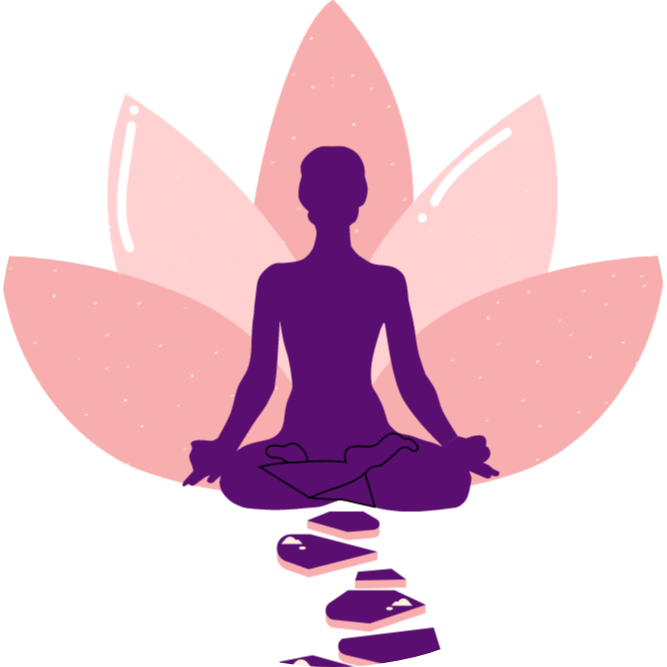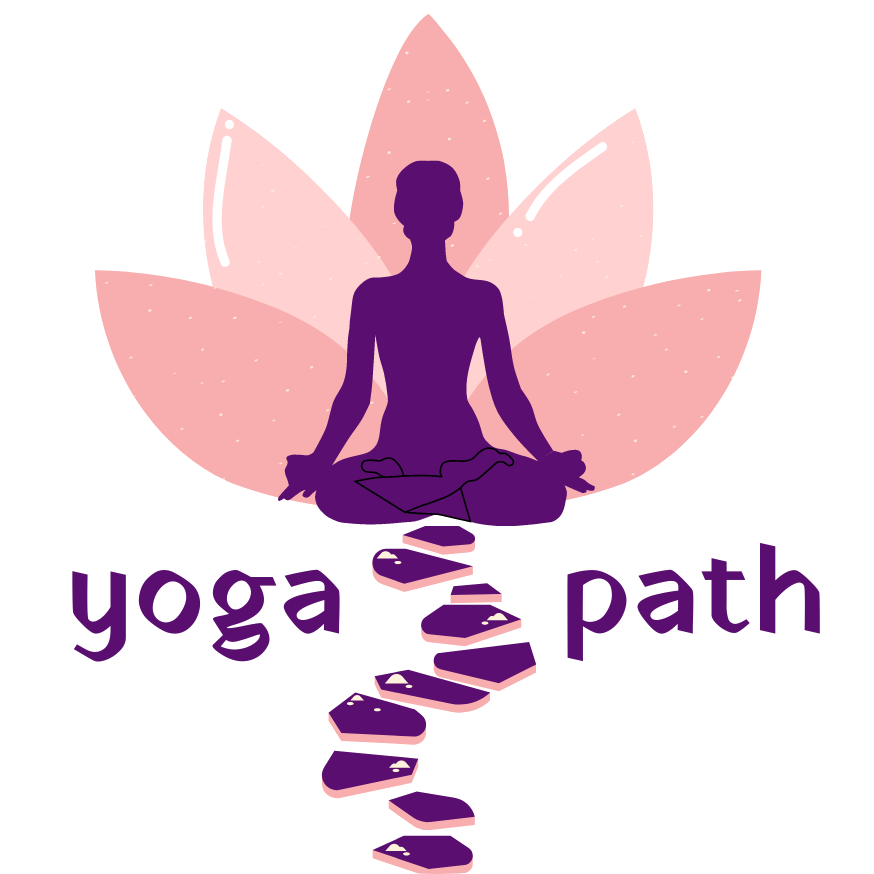International Yoga Day - 21 June '21
Learn an Asana-a-Day for 21 Days
International Yoga Day is just 21 days away and what better time to start down the path of Yoga, than right now?
In recognition of the current times, this year’s theme focuses on ‘Yoga at home and Yoga with family’. Building a strong immunity, while exercising at home is the need of the hour and we are here to bring the practice of yoga to your homes, to help you adopt a healthy lifestyle.
So, get out your yoga mat and prepare to heal your body and relax your mind as we bring you an asana or posture, every day for the next 21 days.
Celebrate International Yoga Day with Yoga Path!
Join us for a
FREE ONLINE YOGA CLASS
21 June '21
8am to 9am IST
Day 21 – Matsyasana
Supine Pose – Lying down with backward bending
Matsya Asana meaning the Fish pose.
In this asana, lie on your back, with feet together and hands relaxed alongside the body. Place the hands underneath the hips, palms facing down. Bring the elbows closer toward each other.
Inhaling lift the head and chest up.
Keep the chest raised and expanded, lower the head backward and touch the top (crown) of the head to the floor, placing the weight on the elbow.
Press the legs to the floor. Hold the pose for 6 seconds to 1 minute. Relax and breathe deeply.
Lift the head up, lower the chest and head to the floor. Bring the hands back along the sides of the body. Relax.
Contraindications:
High or low blood pressure, Migraine and insomnia, serious lower-back or Neck injuries.
Benefits:
Stretches the chest and neck.
Helps relieve tension in the neck and shoulders.
Expands lungs and improves respiratory system.
Tones the parathyroid, pituitary and pineal glands.
Heals reproductive disorders.
Day 20 – Viparit Karni
Supine Pose – Lying down with legs up against a wall
The pose described here is a passive, supported variation of the shoulder stand-like Viparit Karni. You’ll also need to rest your legs vertically on a wall or similar upright support.
Sit sideways with your right side against the wall, lie down lowering your back and head on the floor.
Exhale and, slowly slide your legs up onto the wall sideways while your back, shoulders and head are down on the floor.
Lift and release the base of your skull away from the back of your neck and soften your throat. Don’t push your chin against your sternum.
Open your shoulder blades away from the spine and release your hands and arms out to your sides, palms up.
Keep your legs straight. Feel the weight of your legs and belly deeply into your torso, toward the back of the pelvis. Soften your eyes and turn them down to look into your heart.
Stay in this pose for 1 minute you can increase to 15 minutes. Then bend your legs, and turn to the side.
Stay on your side for a few breaths, and come up to sitting with an exhalation.
Contraindications:
Glaucoma and serious eye problems, Back injury or problems or Neck injury or problems. Not to be done during Menstruation.
Benefits:
Helps ease Anxiety, mild Depression and calms the mind.
Heals Migraines, Headaches, Arthritis, Digestive problems, High and low blood pressure, Respiratory ailments, Uinary disorders, Varicose veins, Piles, Fissures and relaxes cramped legs and feet and reduces Insomnia.
Benefits circulation in the lower back and the abdomen region and its internal organs.
In women, it eases Menstrual cramps, Premenstrual syndrome and Menopause.
Benefits as described in Yoga Philosophy:
- “You will become adept in all the worlds and will not perish even at world dissolution (pralaya)” – Gheranda Samhita 3.36
- Hatha Yoga Pradipika 3.82 states grey hairs and wrinkles reduce
Day 19 – Uthkatasana
Standing Asana
Uth – means raise, kat means waist. This pose is also known as the Chair Pose.
Stand with your feet slightly apart. Stretch your hands to the front with palms facing downwards, with elbows straight.
Bend the knees and gently push your pelvis down and backwards as you exhale in 3 seconds as if you are sitting on an imaginary chair.
With awareness, sit straight and lengthen your spine.
Relax. Sink deeper into the chair.
Hold for 6 seconds – gradually increase to 1 minute.
Ensure that your knees don’t bend and cross ahead of your toes.
Inhale straighten up and lower arms to your side. Breathe and smile when holding this pose.
Contraindications:
Chronic knee pain, Arthritis, Ankle injury, any Knee problem or damaged ligaments and pain in the lower back. Headache or Insomnia (sleeplessness).
Benefits:
Exercises the spine, hips, shoulders and chest muscles.
Helps strengthen the lower back and torso.
Tones the thigh and strengthens them as well as ankle, leg and knee muscles.
Stretches Achilles tendon and shins while healing flat feet.
Strengthens the muscles that support the knee.
Tones digestive organs and opens heart.
Balances the body and brings determination in the mind.
Day 18 – Ekpadasana
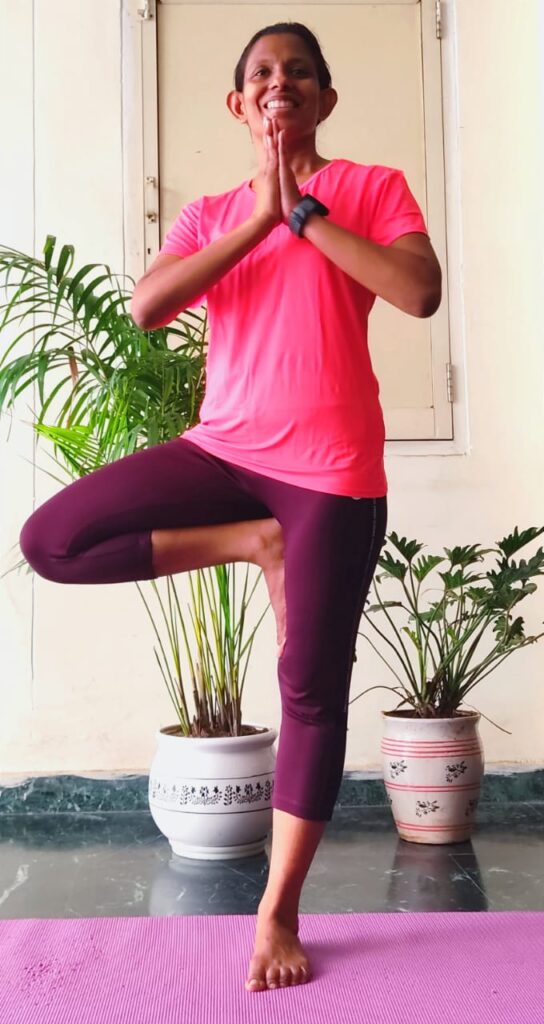
Standing Asana – Balancing Pose
Meaning the One Leg Pose. This asana harmonizes both mind and body.
In this asana, you stand with your feet together and hands by your side.
Raise your right foot and press the sole of your foot against the left thigh as high as you can, close to the groin and toes pointing down. If difficult, avoid placing the foot against the knees but rest the foot, wherever comfortable, against the thigh.
Balance your body weight on the right leg. Once the balance is achieved, join both your palms in a prayer pose. Breathe normally.
Maintain the pose for a few seconds. Try to fix your gaze at one point ahead to maintain balance.
Bring your leg down and hands down by the sides and repeat the same procedure with the opposite leg. You can hold the pose up to a minute.
Contraindications:
Severe arthritis, Lower back pain, Sciatica, Slipped disc, vertigo. Those with weak legs, lack of or very weak neuromuscular coordination.Benefits:
Strengthens the muscles of the legs and spine.
Improves your body balance, endurance, and alertness.
Strengthens the bones.
Stimulates the nervous system.
Improves concentration focus and ability to balance.
Calms the mind.
Day 17 – Setubandasana
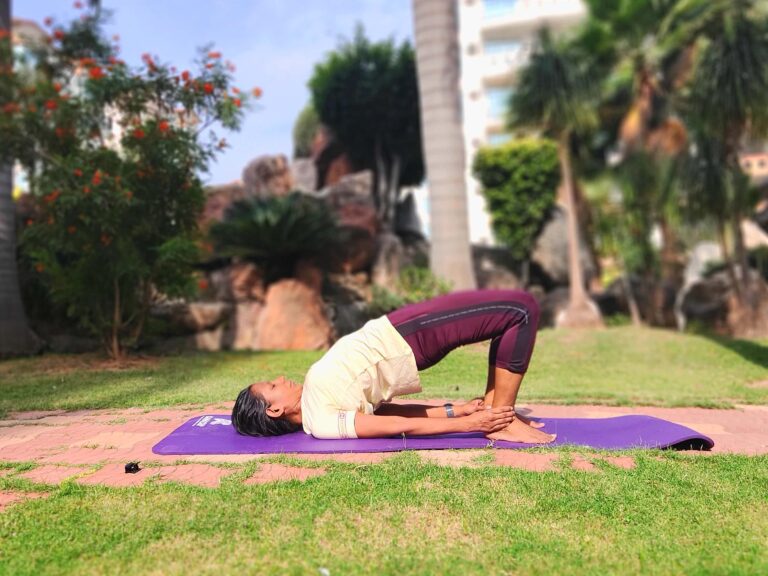
Supine Asana
Setu meaning Bridge; Bandha meaning Bind or Lock;
To begin, lie on your back. Fold your knees and keep your feet hip distance apart on the floor, close to your pelvis, with knees and ankles in a straight line.
Place your palms on your ankles. Inhaling, slowly lift your lower back, middle back and upper back off the floor; gently roll the shoulders inwards; raise the chest to the chin supporting your weight with your shoulders, arms and feet.
Both the thighs are parallel to each other and to the floor. Hold this pose for few breaths. exhale as you gently release the pose.
Contraindications:
Neck injuries, Shoulder or back injuries or surgery, Hypertension, Heart ailments, Myopia and Glaucoma or retinal detachment.
Benefits:
Strengthens the back muscles
Relaxes back instantaneously
Gives a good stretch to the chest, neck and spine
Opens up the lungs and reduces thyroid problems
Strengthens glutes and quadriceps
Calms the brain, reducing anxiety, stress and depression
Helps improve digestion
Helps relieve the symptoms of menopause and menstrual pain
Helpful in asthma, high blood pressure, osteoporosis, and sinusitis
Day 16 – Supta Vakrasana
Supine Position – Spinal torsion
Lie down on your back on the mat, legs stretched forward and hands by the sides Stretch the arms out, perpendicular to the body in a T.
Now, fold the legs at the knees and draw the feet in. Keep the feet and knees together, perpendicular to the floor. Inhale normally. Exhaling, in gently let the legs fall together to the left, to allow the knees to rest on the floor with both knees one above the other. Simultaneously, turn the neck to the right, to gaze at the right thumb.
Hold this pose for few seconds, with the breath suspended. Move the legs raising the knees back up while inhaling. Without a pause, exhaling, in 3 seconds, repeat the above steps to the right, to complete 1 round.
Contraindications:
Severe back pain, Abdominal inflammations, Ulcers and Sciatica.
Benefits:
Exercises and relaxes the spinal muscles
Gently exercises the abdominal and back muscles
Helps alleviate chronic back and shoulder pain
Lower back – strengthens muscles, relieves stiffness and alleviates pain
Improves digestion and combats constipation
Trims the waist line and reduces abdominal fat
Improves functioning of thyroid and muscles of eyes
Day 15 – Dandasana
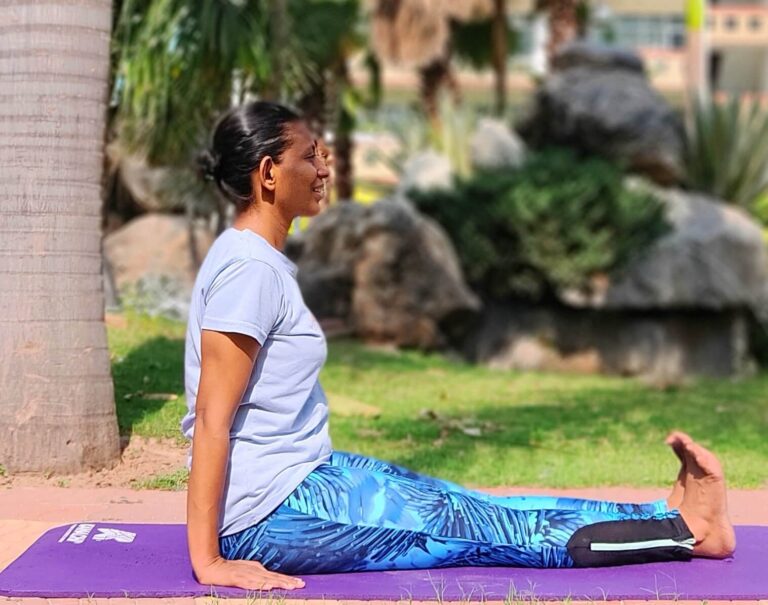
Seated Pose
Danda Asana means stick / staff pose.
In this asana, you have to keep your feet and back straight at a right angle to each other in a sitting position. This is the simplest Asana to do for all age groups.
Sit on the ground with your back straight and legs extended out in front of you. Sit on the mat and lengthen and straighten the spine. Flex your feet, press out the heels and point the toes towards you.
Place your palms on the ground next to your hips, square out your shoulders yet let them be relaxed and not hunched, and expand the chest out. Press the palms firmly into the ground this will raise the hips slightly but the spine is straight, the legs are straight, thighs engaged and knees are pressed into the ground.
Hold this pose for six seconds and increase to thirty seconds.
Contraindications:
Injury to wrist or back.
Benefits:
Increase the flexibility of the hips and pelvis
Strengthens back muscles
Lengthens and stretches the spine
Improves the posture
Helps blood circulation to reproductive organs
Stretches shoulders and chest
Nourishes your body’s resistance to back and hip injuries
Helps to calm brain
Day 14 – Shalabasana
Prone Pose – Backward Bend
Shalabasana means Locust Pose
Lie on the stomach (prone position), with chin resting on the mat, legs stretched out–toes pointing outwards. Rest the arms by the sides, palms facing up, slightly.
pushed under the thighs. Exhaling, in 3 seconds, raise the right leg as high as possible lifting from thighs contracting lower back and glute muscles without lifting the hips; the left leg is firmly on the ground.
Maintain this pose for 6 seconds
To return to starting position, inhaling, in 3 seconds, gently bring the raised foot down to attain starting position.
Follow same with left leg. Now, perform the Asana with both the legs rising simultaneously, while exhaling to complete 1 round.
Practice 3 rounds.
Contraindications:
Hernia, Hyper tension, Heart ailments, Pregnancy and Peptic ulcers. People with a protruding belly will have difficulty lying in prone position.
Benefits:
Strengthens the lower back, pelvic organs, legs, hip joints and arms.
Tones the sciatic nerves.
Provide relief in backache, mild sciatica and slipped disc.
Alleviates unfavourable conditions of diseases of the stomach and bowels.
Stimulates the kidneys, liver and all the organs of the lower part of the body.
Increases abdominal pressure, regulating intestinal function and stimulating the abdominal organs.
Stimulates the appetite.
Relief from constipation.
Relieves backache during Menstrual cycles.
Cures cervical spondylitis.
Day 13 – Parvatasana
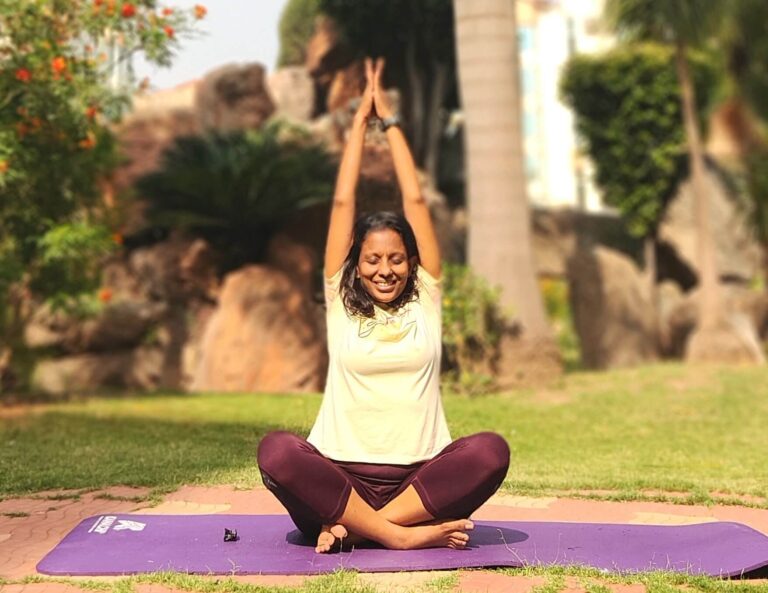
Seated Pose
Sit in Padmasana / Sukhasana, keeping the hands at their respective sides, and keeping the spine and neck straight, shoulders squared out, focus on a single point straight ahead.
Classical Pose:
Inhaling, in 3 seconds, raise both the arms together, from their respective sides, for an upward stretch. Join the palms to each other in this upward stretched position of arms. Either interlace the fingers or keep the palms joined. Keep the arms close to the ears, arms straight at the elbows and wrists. Maintain this position for 6 seconds, . Return to starting position exhale, in 3 seconds, turn the palm outwards and lower the arms straight down to the sides to complete 1 round. Practice 4 rounds.
Benefits:
Corrects minor postural defects of the spine and straightens the muscles of the back
Stretches all the abdominal and pelvic muscles and opens the hip joint
Exercises the waist zone, and reduces belly fat and flabby abdomen
Internal organs in the abdominal region get a massage and good blood circulation
Prolapse of the uterus is improved by providing natural support to the viscera
Blood circulation in the vertebral region improves, and the efficiency of the nerves coming out of the vertebra is improved
It reduces mental fatigue while improving memory and concentration by increasing blood circulation to the brain
The unnatural curvature of the spine and minor displacements of the vertebrae are corrected
Day 12 – Bhujanga Asana
Prone Position – Back Bend
Bhujanga Asana meaning Cobra Pose, is also a part of the Surya Namaskar (salute to the sun)
Lie down on your abdomen with your toes flat on the floor, soles facing upwards; rest your forehead on the ground. Keep your legs close together, with your feet and heels lightly touching each other. Place both palms beside the chest elbows should be bent and close to your torso.
As you inhale slowly lift your head, chest and upper part of abdomen. Keep your navel on the floor. Keep elbows close to body.
Keep breathing with awareness, as you curve your spine upward vertebra .by vertebra look straight ahead. Maintain this pose for a few seconds while breathing evenly for 4-5 breaths.
Now, breathe out, and gently bring your abdomen, chest, and head back to the floor and relax.
Contraindications:
Hernia, Hypertension, Heart Ailments, Pregnancy, Peptic ulcer and Hyper thyroid
Benefits:
Helps align vertebra
Strengthens Muscles of Back and spine and keeps spine flexible
Relief from back pain
Stimulates spinal nerves
Tones abdominal muscles And organs
Alleviates constipation
Stimulates appetite
Prevents diseases by aiding in elimination through intra abdominal pressure
Relief from flatulence
Helps resolving slipped disc
Relief in Ankylosing Spondylitis and kyphosis
Helps in menstrual and gynaecological disorders
Strengthens willpower, alertness and increases determination
Day 11 – Adho Mukho Shvanasana
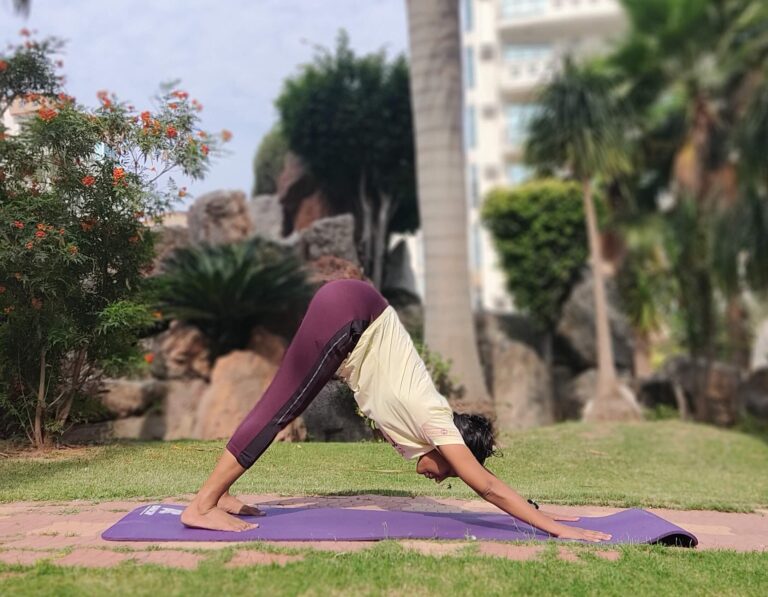
Inversion Asana
Adho meaning down, mukho meaning Face, svana meaning Dog. This asana too is part of the flow of surya namasakar (salute to the sun).
The name is derived from the way the dog stretches his front limbs when getting up.
In this pose, we can start by sitting on all fours in a table top position with knees and palms on the floor. The palms are at shoulder distance on the floor also the knees and feet are at hip distance apart. Lift the knees up to raise the hips up as you inhale. The weight of the body is on both palms and feet. With both arms straight at the elbows and the legs being straight at the knees the hips are raised up the head is down with arms close to the ears. We try to press the chest into the thighs just as we try to close a book to make a V shape. As you exhale, lower down the knees, hips and back into table top.
Contraindications:
Pregnant women, high blood pressure, Weak eye capillaries,
detached retina, or any other infection or inflammation of the eyes and ears and shoulder or back injury
Benefits:
Stretches the hamstring and calf muscles
Strengthens arms and shoulders, legs and ankles
Relaxes and strengthens back muscle
Strengthens abdominal muscles and core
Improves posture
And calms the heart
BKS Iyengar claimed that Downward Dog “removed fatigue”, especially for runners.
He claimed that sprinters would develop “speed and lightness in the legs”, and that the pose would soften calcaneal spurs.
Day 10 – Marjari Asana & Bitila Asana
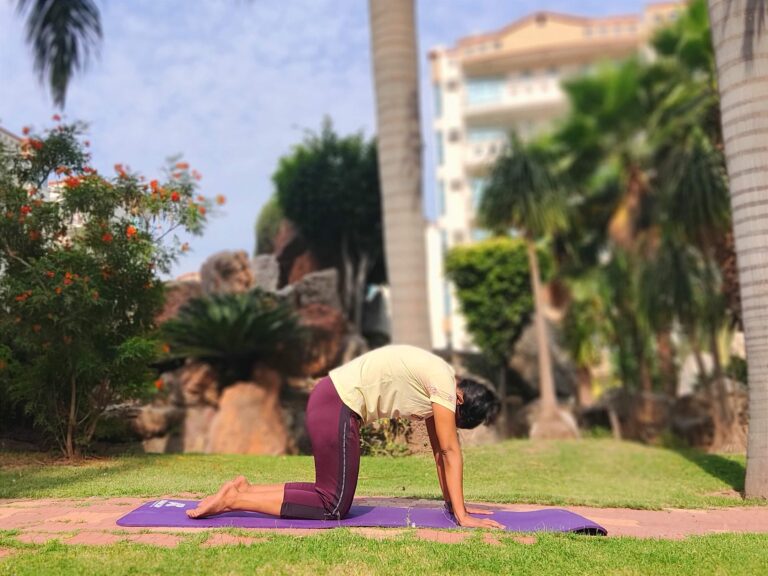
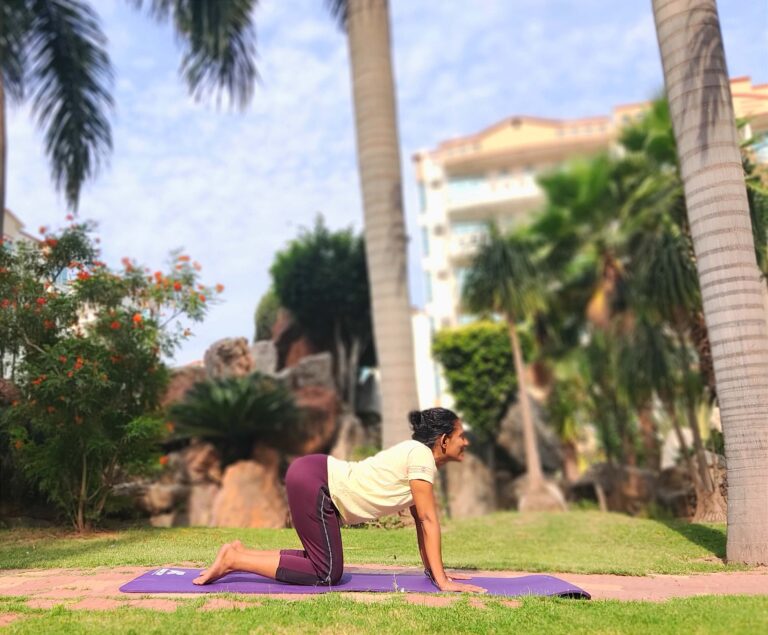
Forward Bend & Backward Bend
Marjari meaning Cat, Bitila meaning Cow
In this asana, sit in Vajrasana then come on all fours or table top with with knees and palms on the floor. The palms are at shoulder distance on the floor also the knees and feet are at hip distance apart. The palms are directly under the shoulder with arm perpendicular to the floor and the knees are under the hips. Look straight ahead. As you inhale, raise your chin, tilt your head and chest back pushing the palms firmly into ground push your navel downwards and raise your tailbone. Hold this cat pose and take long, deep breaths.
Follow this by Bitilasana, a counter pose: As you exhale, drop your chin to your chest and arch your back up as much as you can; pull in the pelvic and chest to form a curve in the spine. Hold this pose for a few seconds.
Contraindications:
Weak wrists injury or surgery to wrists
Shoulder injury back injury
Weak or injured knee – use padding under knees
Benefits:
Brings flexibility to the spine
Stretches the back and relaxes it
Stretches the scapula out and in and increases mobility
Strengthens lower back
Strengthens wrists and shoulders
Massages the digestive organs and improves digestion
Tones the abdomen
Relaxes the mind
Relieves menstrual pain
Improves focus
Improves blood circulation
Day 9 – Pawanmuktasana
Supine / Lying down Asana
Pawan meaning gas, Mukta meaning releasing. Pawanmuktasana is an anti-flatus pose, excellent for releasing gas.
In this asana, lie supine at full length on a mat, feet together and hands resting beside the body. Relax mind and calm and body. Inhale normally.
Exhaling in 3 seconds, bend both the legs at the knee and draw it towards the abdomen. Wrap the forearms just below the knee (the fingers clasping the opposite elbows), and keep it firmly pressed against the chest. Ensure to rest the head and neck on the floor.
Maintain this pose for 6 seconds. Inhaling, in 3 seconds, gently release the clasped hands and slowly straighten the leg to bring it back to the starting position. You can hold position for 30 seconds and increase to 2 minutes.
Contraindications:
Abdominal inflammation, Cardiac conditions, Hernia, Piles, Menstruation and Pregnancy.
Benefits:
This posture gives significant relief to flatulence by quickening the movement and expulsion of the intestinal flatus.
Favourable improvement in cases of flabby abdomen, sub-normal functions of the abdominal viscera and pelvic organs.
Relief in case of chronic constipation and sluggish liver.
It sharpens the brain, improves concentration, calms you and reduces mental problems.
Shoulder muscles, triceps, gluteus maximus and hamstrings are stretched.
Offers deep internal pressure massage.
Inculcates a feeling of “letting go”.
Day 8 – Mandukasana
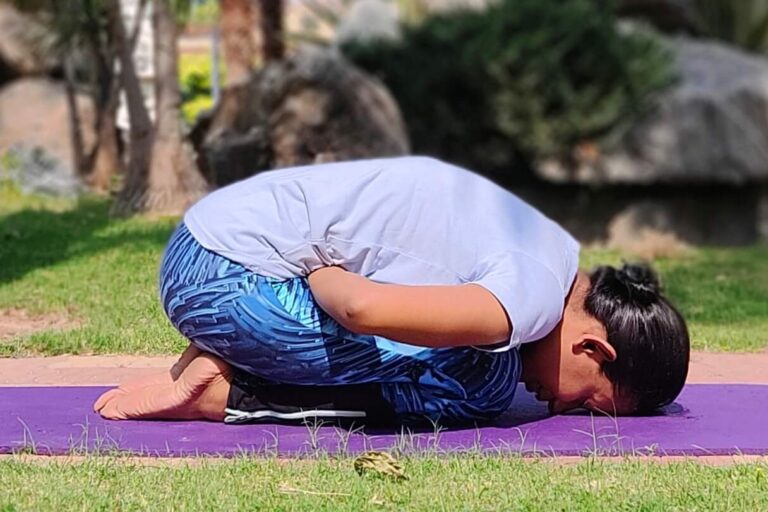
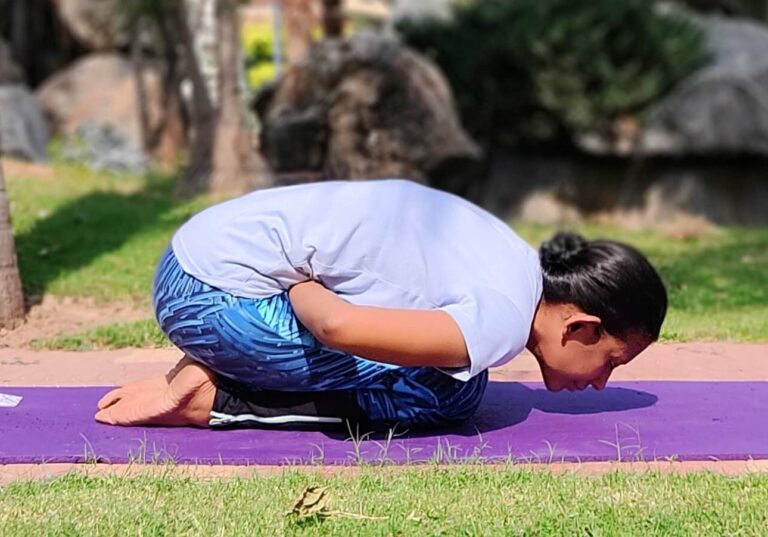
Seated Asana – Forward bending
Manduka meaning Frog
- In this pose, as you inhale in 3 seconds, form a fist folding the thumb inside the fingers and place it below and on both sides of your navel with elbows pointed out.
- As you exhale in 3 seconds, extend the spine, raise the chest upwards and then lower the torso down. In doing so, the fists are pressed deep in the abdomen in the navel area, the fists are still standing on either side of the navel.
- Lower the head down as much as you can to the floor without lifting thighs off the heel.
- Hold this pose for 1minute.
- Slowly you can increase to 3-5 minutes
Contraindications:
People suffering from Peptic or Duodenal Ulcer, severe Back Pain and Cardiac problem, abdominal surgery should avoid this exercise.
Knee pain patients, those with ankle injuries,
High blood pressure, Insomnia, Migraine and pregnant women should refrain.
Benefits:
This pose is beneficial to all organs of the body.
Relief from diabetes, digestive disorders and constipation.
Improves the flexibility and mobility of the knee and ankle joints.
Tones muscles of the shoulder and abdomen.
Regular practice of this pose increases your lung capacity.
Beneficial for people suffering from ailments of the pancreas and the heart.
Helps reduce fat from thighs, belly and hips.
Day 7 – Vajrasana
Seated Asana
Vajrasana Asana meaning Thunder Bolt Pose
This yoga posture has been named after the shape it takes – that of a diamond or thunderbolt. One can sit in Vajrasana at the time of doing pranayamas.
Assume a kneeling position on a mat with your knees touching each other. Let your toes touch each other and the heels remain apart. Lower your body and sit comfortably in the space between your toes and heels. Place your hands upon your knees with your palms facing downwards.
Close your eyes and passively observe your breath or keep your gaze fixed at one point. Sit for around 5 to 10 minutes.
Contraindications:
Acute arthritis and very high or low blood pressure.
Benefits:
It stretches the thighs, calves, ankles and hips.
It stretches the spine, corrects postural defects.
It improves blood circulation to the abdominal region thus helping improve digestion
Alleviates sciatica or severe lower back problems or constipation or stomach disorder or digestive problems or acidity
Hence with improved digestion and assimilation hairfall is greatly reduced
Flexibility of the lower limbs
The generative organs are toned
It provides relief from urinary problems.
This posture calms the mind and relaxes the nerves.
If you want to put pressure on Surya Nadi allow the left toe to rest on the right toe
If you want to put pressure on Chandra Nadi allow the right toe to rest on the left toe
Day 6 – Trikonasana
Standing Position – Sideward Bend
Trikona meaning Triangle
In this pose, begin with both feet 3 feet apart. Turn the right foot out pointing to the right at a right angle to the left foot.
Inhaling in 3 seconds raise both arms out at shoulder level with palms facing downward.
Exhaling in 3 seconds and gazing at the right palm, extend and lower the right palm to the right foot at the same time raising the left arm straight above .Then turn the gaze to the left thumb of the arm above. The legs and hands are straight. The upper left hand and lower right hand are aligned in one straight line lift the left shoulder up so that the shoulder is also in one line aligned with the arms.
Hold this pose for 6 seconds.
As you exhale in 3 seconds turn your gaze to the lower arm, raise both arms to shoulder level and lower them down by your sides.
Repeat the same on the left side.
This is one round. Practise 3 rounds.
Contraindications:
Spinal injury, Back injury or Shoulder injury, Frozen shoulder, severe Arthritis, Hypertension and serious cardiac complaints.
Benefits:
Stretches, develops and tones the muscles of the sides and the obliques
Strengthens the back and improves posture
A very good compression and twist to the abdomen and the organs therein
Improves digestion
Stimulates the nervous system
Relieves symptoms of menopause
Day 5 – Konasana 1
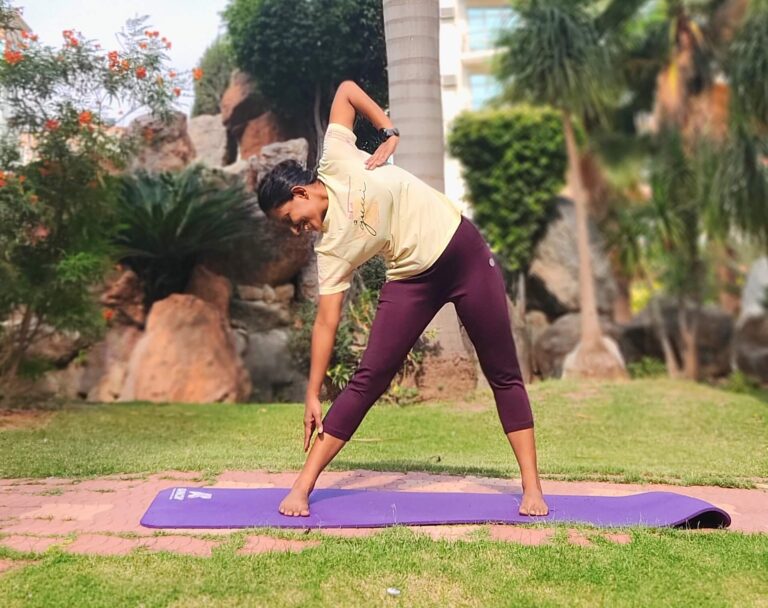
Standing Position – Sideward Bend
Kona is Angle; Konasana meaning Angle Pose.
In this asana, begin with standing 2 feet apart with the feet parallel to each other and both arms by the side.
Raise the right palm to waist with fingers facing forward and thumb behind.
As you inhale in 3 seconds turn the head to gaze over the left shoulder and bend the torso to the left side and raise the right palm to armpit with elbow pointing to the ceiling and slide the left arm down straight as you continue gazing at the left hand.
The thorax, neck and the head is then at a right angle to the base. Ensure the body does not incline forward but sidewards in an aligned vertical plane.
Hold this pose for 6 seconds.
While exhaling smoothly raise the torso back to the starting position and the hands slide back to their respective sides. Repeat the same on the other side. Repeat the same on the left side to complete 1 round. Practise 2 full rounds.
Contraindications:
Spinal injury, Back injury or Shoulder injury, Frozen shoulder and severe Arthritis, Hypertension and serious cardiac complaints. Pregnant women in 2nd & 3rd Trimester must refrain.
Benefits:
Stretches the sides of the body and the spine
Strengthens intercostal muscles and hence breathing capacity
Helps in toning arms, legs, plus abdominal and pelvic organs
Helpful in relieving back pain
Increases the flexibility of the spine
Helps those who are suffering from constipation
Helpful for people suffering from sciatica
Konasana 1 is a preparatory asana for Urdhva Hastasana and Ardha Chakrasana. So practice Konasana well and we will soon learn these advanced asanas.
Day 4 – Shashank Asana
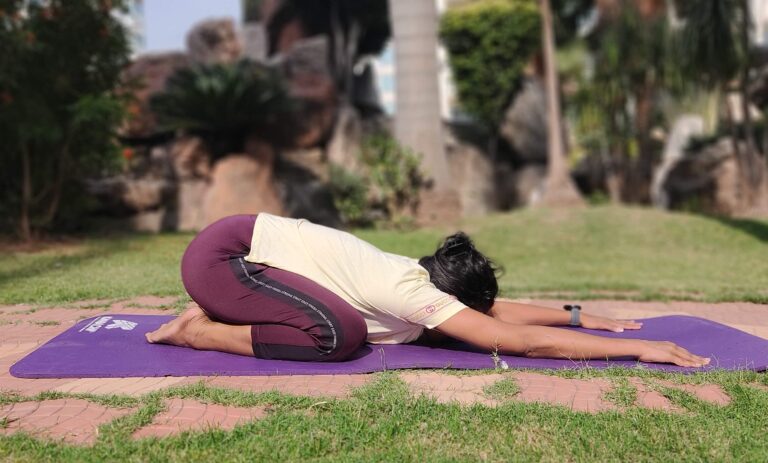
Prone Position – Forward Bend
Shashank Asana meaning Hare Pose.
In this asana, sit in Vajrasana resting the palms on the thighs. Spread the knees out. Inhale and raise the arms above the head. Elbows must be straight, maintain shoulder width apart distance between the arms. Exhale and slowly bend the torso forward and place forehead palms, elbows and arms stretched out in front between the knees on the floor. Bend from the pelvic region. The hips should remain touching the heels. Retain the position as long as comfortable. It could be practiced from a minute to 5 minutes. To go back in the base position, exhale and slowly lift the forehead, arms above head. Lower the arms resting the palms on the thighs. Relax and take a deep breath.
Contraindications:
Vertigo, high blood pressure, knee problems or slipped disc.
Pregnant women should refrain from practising this asana.
Benefits:
Massages the abdominal organs, muscles and organs of the pelvic region.
Improves digestion and alleviates constipation.
Relaxes the spine and all muscles of back.
Improves functioning of adrenal glands.
Stretches back muscles and strengthens it.
Enhances the health of reproductive organs.
Relaxes sciatica nerve.
Improves blood supply to the head and therefore nourishes the eyes and all brain functions.
Helps to relieve fatigue and promotes concentration.
Day 3 – Urdhva Uttanasana
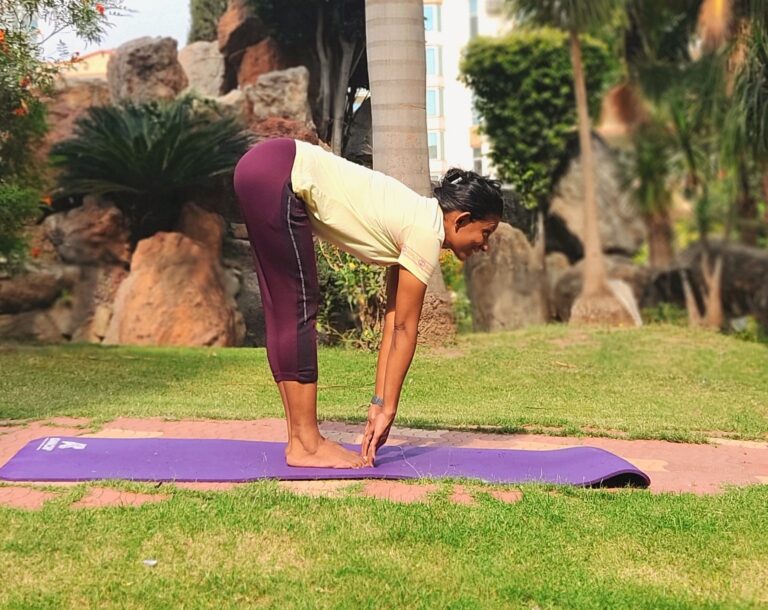
Standing Position – Forward Bend
Urdhva – upward or lifted – stretched Asana – pose
In this pose, keep your feet one foot apart, parallel to each other.
Lift arms up above as you inhale in 3 seconds, keeping arms close to your ears.
As you exhale in 3 seconds lower arms and bend torso too. Continue lowering arms till they touch toes. Lift chest. The arms are by the ears and head and hands move as one unit.
Lengthen the spine, and look up so the back is flattened and is parallel to the floor. Hold this pose for 6 seconds.
As you inhale in 3 seconds, raise the torso and arms back up and exhale in 3 seconds and lower them down to the sides.
Practise 3 rounds.
Contraindications:
Lower back injury, Glaucoma, Tear in the hamstrings, High blood pressure, Abdominal hernia, Cervical – don’t stretch neck up or down.
Benefits:
Strengthens and stretches back muscles
Strengthens quadriceps and hamstrings
It stretches abdomen and helps massage abdominal organs
Helps relieve constipation, indigestion and gas problems
Also helps increase metabolism
Day 2 – Samakonasana
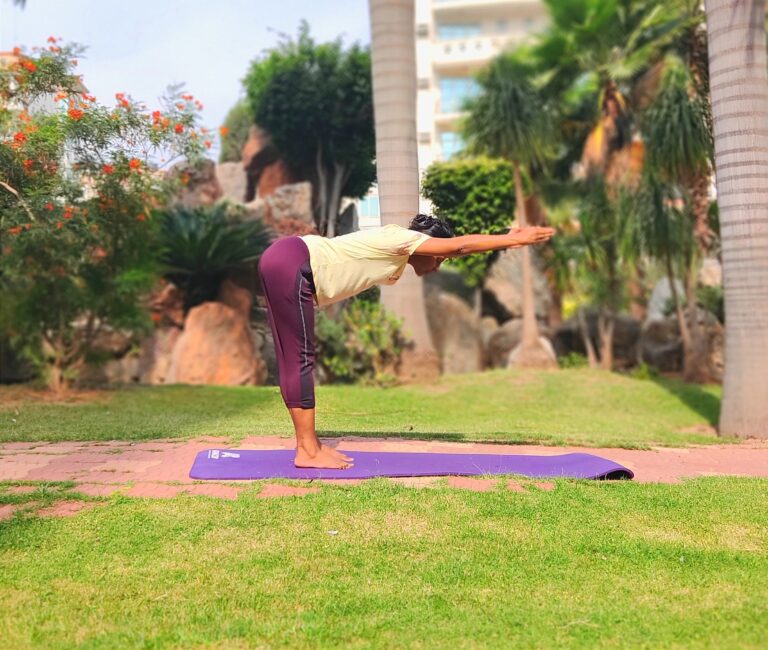
Standing Position – Forward Bend
Sama meaning straight , Kona meaning angle
In this asana we start with feet one foot apart the feet parallel to each other and arms relaxed by your sides As you inhale raise both hands straight above with elbows straight arms close to ears. As you exhale bend forward from waist with arms also straight ahead and close to ears. The back must be straight and parallel to the floor, lengthen the spine. As you inhale, raise the torso and arms back up and lower them down to sides.
Contraindications:
Back injury , Knee injury, Joint pain and Migraine
Benefits:
Strengthens and stretches back muscles
Strengthens quadriceps and hamstrings
It stretches abdomen and helps massage abdominal organs
Helps relieve constipation, indigestion and gas problems
Also helps increase metabolism
Day 1 – Talasana
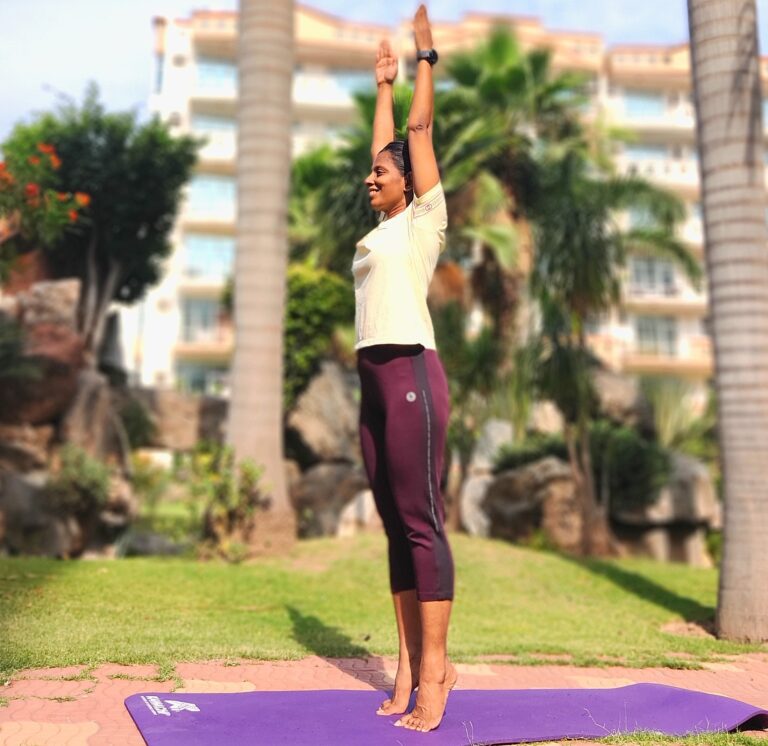
Standing Position – Upward Stretch
In this pose, stand erect with hands at their respective sides. Keep the feet parallel to each other and maintain a one-foot distance between them.
1. Inhaling, raise both arms up above head. Keep the arms close to the ear.
2. Simultaneously, raise both the heels, to achieve a maximum stretch of the body.
Synchronise the first two steps, while inhaling, in 3 seconds.
Now, balancing on the balls of the feet, with the completed upward stretch of the arm and the body, keep the gaze straight ahead and maintain the pose for 6 seconds, retaining the breath (final position).
Return to starting position:
Turn the palms to face outward and then exhaling, bring the arms down keeping them straight through a backward and downward circuit. Simultaneously, lower the heels to assume the starting position.
Contraindications:
Frozen shoulders, Arthritis, Hypertension and serious cardiac complaintsBenefits:
Helps increase the girth and contour of the chest.
Develops the respiratory muscles and the vital index.
Improves elasticity, capacity and circulation of the lungs.
Improves the venous flow –equalises blood circulation.
The flexibility of the spinal column improves.
Tenses/tones the usually relaxed muscles of the abdomen.
Muscles of the leg are toned and improvement in the functioning of the veins.
Due to the stretch of the vertebral column, undue pressure on the vertebrae is relieved.
